In the context of the UN Biodiversity Conference (CBD COP15), the European Bureau for Conservation and Development (EBCD) in collaboration with the IUCN-CEM Fisheries Expert Group, the Convention on Biological Diversity (CBD) and the Food and Agriculture Organization (FAO) hosted the side event Fisheries in the Post-2020 Global Biodiversity Framework: where and how do they fit?, which took place on the 8th of December in Montréal, Canada.
The panel was moderated by Kim Friedman (FAO) and included Jake Rice (Vice-chair IUCN-CEM Fisheries Expert Group), Renée Sauvé (Canadian delegation), Rudi Cloete (Namibian delegation), Vivienne Solis Rivera (Coopesolidar), Sophie Benbow (Fauna & Flora International), Paul Lansbergen (International Coalition of Fisheries Associations) and Joe Appiott (CBD Secretariat).
The event speakers discussed a number of fishery-related issues in the context of the evolving CBD negotiations to establish a global plan for nature and people, the Post-2020 Global Biodiversity Framework. Some key messages from this are summarised below:
Sustainable use
Sustainable use is one of the three pillars of the Convention on Biological Diversity. Members of the Panel reminded that the use of aquatic biodiversity for food is not an option, and this use supports the livelihoods of over a third of the world’s population who directly rely on aquatic biodiversity. The experts highlighted the need for a stronger focus to be placed on the positive relationship sustainable use can deliver for conservation of biodiversity, and the need for this message to be integral to the GBF. Sustainable use is also crucial for a majority of rightsholders whose life depend on marine resources and whose efforts towards marine conservation must be recognized. The message of the Global Biodiversity Framework therefore should blend concepts of minimizing long term harm to biodiversity from unsustainable uses with promotion of pathways to positive outcomes that comes from custodianship (otherwise known as wise use) of biodiversity.
Mainstreaming
Biodiversity mainstreaming was central to CBD Decisions in CoP13 in Mexico where the value of including use sectors in the delivery of the CBD vision for conservation was elevated. Now in 2022 promotion of the actions of use sectors seems less prominent in the draft GBF. This may partly reflect the increasing successes in mainstreaming of biodiversity in sectors such as fishing, as the CBD Secretariat representative stated that “mainstreaming has been mainstreamed”, but other considerations are also in play. More headline-grabbing themes of the evolving GBF, such as the ‘30×30’ goal for protected areas and ‘Nature-based Solutions’ are leading messages in the on-going dialogue, both in the meeting rooms and in the media. The Panel included evidence from fisheries of successful outcomes for biodiversity ranging from examples from small scale fishers whose communities had fished their traditional areas for generations to summaries of both technical and market measures highlighting effective actions in addressing issues such as bycatches, habitat impacts and overfishing. Yet biodiversity challenges are still encountered in fisheries, and contributions to addressing those challenges by responsible actors ranging from Indigenous Peoples and Local Communities to large scale harvesters and commercial markets are less well acknowledged, supported, and expanded. These actions need to be given focus and their success shared widely across the varied community of fisheries value chains.
A clear pathway for fisheries to deliver in the Post-2020 Global Biodiversity Framework
It is important to remember that fish are biodiversity (the group with the largest mass of backboned animals on earth), and sustainable fisheries are critical to the global food system and many economies. Fisheries and aquaculture will continue. The panel presented evidence that fishing leaves you with more nature than other activities, given that it is a low user of water, and is directly dependent on renewable production of wild aquatic life. Today the original aquatic ecosystem remains productive and present, rather than replaced, as it is in many other human activities. To make sure that fisheries and aquaculture sectors continue to contribute meaningfully to biodiversity goals, the GBF must explicitly recognize current successes together with current challenges, and incentivize additional efforts where needed.
The upcoming renewal of the marine program of the CBD presents a unique opportunity for the CBD to engage with partners like FAO, fishers and marketing organizations, and the IUCN Fisheries Expert Group in delivering on GBF objectives. They will join the other productive sectors in efforts to achieve the biodiversity goals and targets of the GBF, helping to deliver the capacity and tools needed for CBD Parties to strengthen spatial (e.g. Other Effective Conservation Measures (OECMs), species and ecosystem approaches to deliver biodiversity conservation in a framework of equity and justice.




